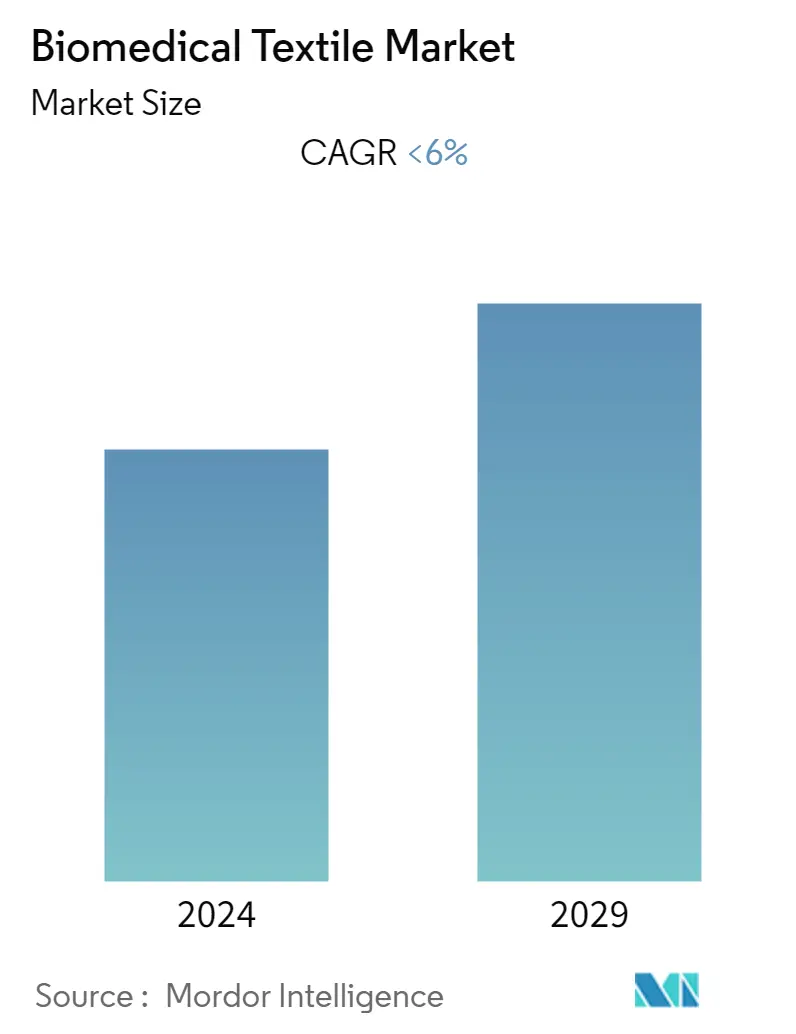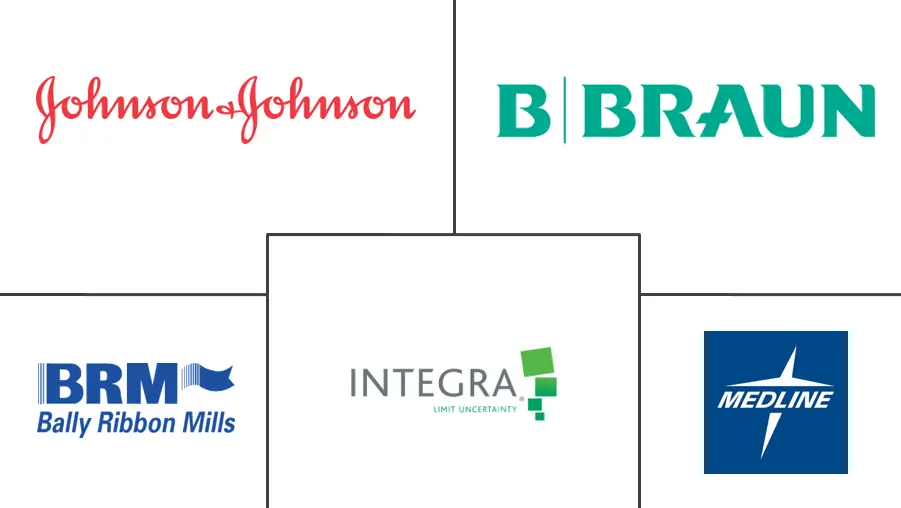Market Size of Biomedical Textile Industry

| Study Period | 2019 - 2029 |
| Base Year For Estimation | 2023 |
| CAGR | 6.00 % |
| Fastest Growing Market | Asia Pacific |
| Largest Market | North America |
| Market Concentration | Medium |
Major Players
*Disclaimer: Major Players sorted in no particular order |
Biomedical Textile Market Analysis
The market for biomedical textiles is expected to grow at a CAGR of about 6% globally during the forecast period. The major factors driving the market are the rising number of surgeries and the growing need for high-quality wound dressing material are driving the market growth. On the flip side, the high cost of vascular grafts & artificial skin and the complexity in the integration of electronic circuits in textiles for data processing are hindering the market growth.
- The implantable segment is expected to dominate the global biomedical textile market over the forecast period.
- North America region represents the largest market over the forecast period owing to the increasing consumption from countries such as the United States, and Canada.
Biomedical Textile Industry Segmentation
The biomedical textiles market report includes:
| Fiber Type | |
| Non-biodegradable Fiber | |
| Biodegradable Fiber |
| Fabric Type | |
| Non-woven | |
| Woven | |
| Other Fabric Types |
| Application | |
| Non-implantable | |
| Implantable | |
| Other Applications |
| Geography | |||||||
| |||||||
| |||||||
| |||||||
| Rest of the World |
Biomedical Textile Market Size Summary
The biomedical textile market is poised for significant growth, driven by an increasing number of surgical procedures and the rising demand for high-quality wound dressing materials. These textiles are increasingly utilized in medical applications such as artificial arteries, sutures, and vascular grafts, playing a crucial role in replacing and aiding damaged body parts. The implantable segment is anticipated to lead the market, supported by the growing aging population, the prevalence of chronic diseases, and technological advancements in healthcare. However, challenges such as the high cost of vascular grafts and artificial skin, along with the complexity of integrating electronic circuits into textiles, may impede market expansion.
North America is expected to maintain its dominance in the global biomedical textile market, largely due to its advanced healthcare infrastructure and ongoing investments in medical technology. The region's growing obesity rates and associated health issues have led to an increased demand for biomedical textiles in various medical applications. The market is characterized by a partial consolidation, with major players like Johnson & Johnson Services Inc., Integra LifeSciences Corporation, and B. Braun Melsungen AG holding significant market shares. These companies are pivotal in driving innovation and meeting the rising demand for advanced medical devices and components essential for modern surgical procedures.
Biomedical Textile Market Size - Table of Contents
-
1. MARKET DYNAMICS
-
1.1 Drivers
-
1.1.1 Rising Number of Surgeries
-
1.1.2 Growing Need for High-Quality Wound Dressing Material
-
-
1.2 Restraints
-
1.2.1 High Cost of Vascular Grafts and Artificial Skin
-
1.2.2 Complication in Integration of Electronics Circuits in Textiles for Data Processing
-
-
1.3 Industry Value Chain Analysis
-
1.4 Porters Five Forces Analysis
-
1.4.1 Threat of New Entrants
-
1.4.2 Bargaining Power of Buyers
-
1.4.3 Bargaining Power of Suppliers
-
1.4.4 Threat of Substitute Products
-
1.4.5 Degree of Competition
-
-
-
2. MARKET SEGMENTATION
-
2.1 Fiber Type
-
2.1.1 Non-biodegradable Fiber
-
2.1.2 Biodegradable Fiber
-
-
2.2 Fabric Type
-
2.2.1 Non-woven
-
2.2.2 Woven
-
2.2.3 Other Fabric Types
-
-
2.3 Application
-
2.3.1 Non-implantable
-
2.3.2 Implantable
-
2.3.3 Other Applications
-
-
2.4 Geography
-
2.4.1 Asia-Pacific
-
2.4.1.1 China
-
2.4.1.2 India
-
2.4.1.3 Japan
-
2.4.1.4 South Korea
-
2.4.1.5 Rest of Asia-Pacific
-
-
2.4.2 North America
-
2.4.2.1 United States
-
2.4.2.2 Canada
-
2.4.2.3 Mexico
-
-
2.4.3 Europe
-
2.4.3.1 Germany
-
2.4.3.2 United Kingdom
-
2.4.3.3 France
-
2.4.3.4 Italy
-
2.4.3.5 Rest of Europe
-
-
2.4.4 Rest of the World
-
-
Biomedical Textile Market Size FAQs
What is the current Biomedical Textile Market size?
The Biomedical Textile Market is projected to register a CAGR of less than 6% during the forecast period (2024-2029)
Who are the key players in Biomedical Textile Market?
Johnson & Johnson Services, Inc. , Integra LifeSciences Corporation , B. Braun Melsungen AG , Medline Industries, Inc. and Bally Ribbon Mills are the major companies operating in the Biomedical Textile Market.

